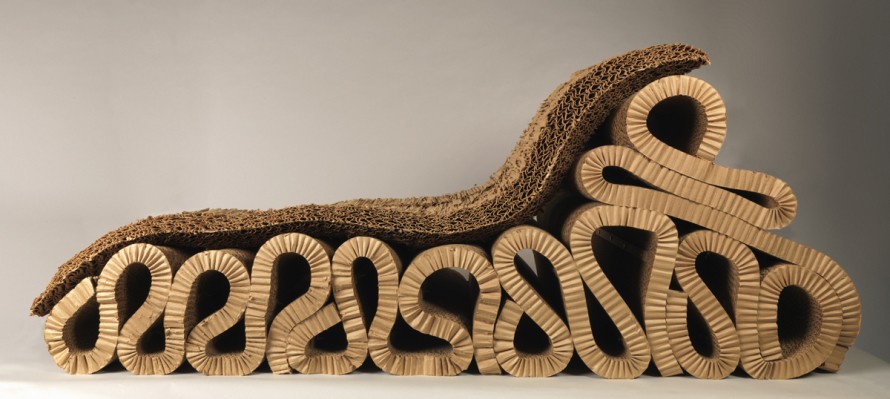Industrial-grade cardboard. Probably not the first material you would associate with the voluptuous ribbon like curves and thick, luxurious looking cushion of architect Frank O. Gehry’s Bubbles chaise longue. Known for his deconstructivist buildings, Canadian-born Gehry experimented with furniture design as early as the late 1960s. He was introduced to furniture design while serving in the U.S. Army where he designed furniture for soldiers.
With the oil crisis of the 1970s, and the growing awareness of the environmental effects of consumer waste, plastic lost some of its appeal. Some designers turned to more ecologically friendly materials. For his furniture designs, Gehry chose the industrial material cardboard, particularly the heavy sturdy type used in hollow-core doors. His first series, called Easy Edges, produced between 1969 and 1973, consisted of inexpensive mass-produced seating and side tables in rectilinear shapes that were sold in department stores. This line, considered the Volkswagen of furniture, was produced to suit the needs of all—young or old, city or country dweller.
Gehry’s second series, Experimental Edges (1979-82), showed a more modernist approach; employing highly curving lines, these very structural pieces were handmade and sold through galleries as limited edition, high-end art furniture. Cooper-Hewitt’s ca. 1988 Bubbles chaise longue embodies such features. Number seven in an edition of fifty, it is constructed of corrugated cardboard with a fire-retardant coating. The arabesque form is dictated by the light-weight cardboard that has been layered and rippled into S-curves and looks like a giant continuous ribbon covered by a thick, layered, almost shaggy-looking cardboard cushion. Gehry has taken this disposable material and made it into a sculptural piece of art furniture, giving the humble, utilitarian substance an extravagant feel. Gehry has said of cardboard: “It is fascinating to work with a material that has resiliency and keeps its form. The aesthetic qualities of it were very special because it looked like corduroy, it felt like corduroy and it was seductive. It was warm and could be used in a variety of settings….”
Gehry’s later experimentation with furniture design included a third series using bent wood, introduced in the early 1990s. The bentwood furniture group for Knoll (each piece named for a different ice hockey term) is still in production today.
Today is Frank O. Gehry’s birthday.
